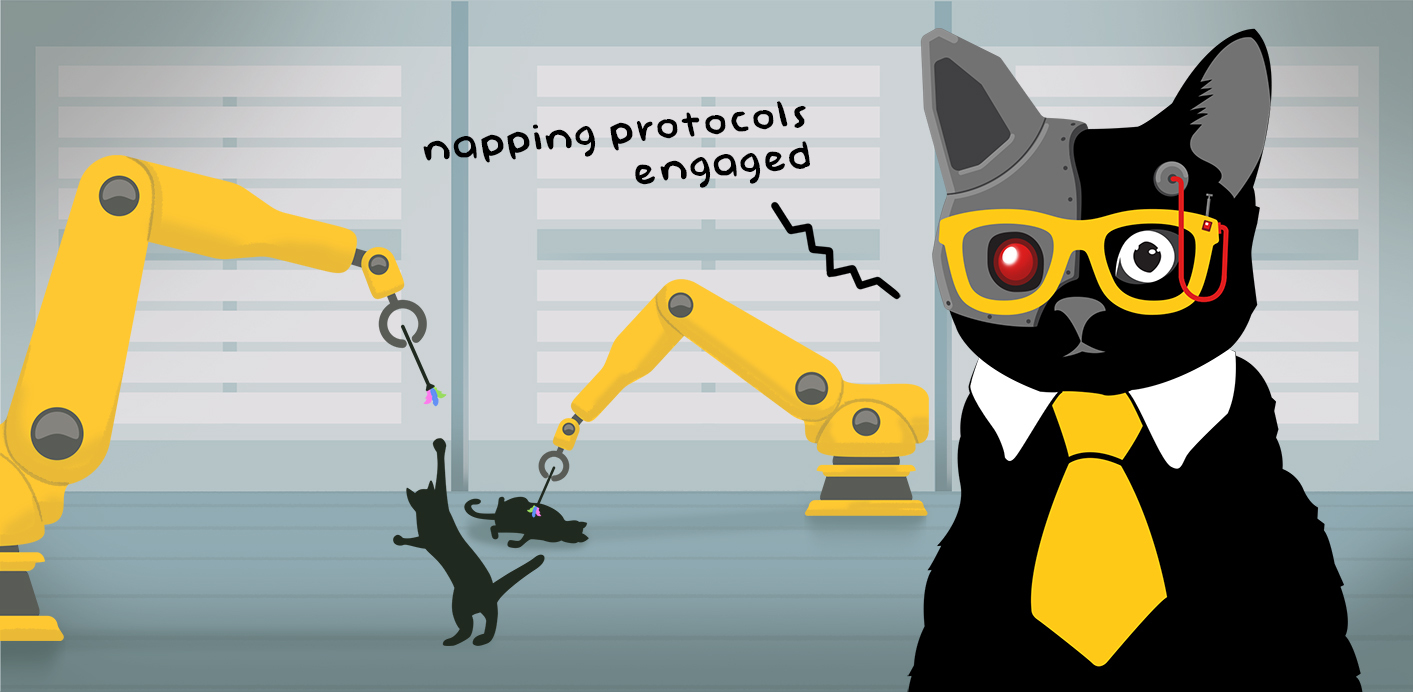To reveal some upcoming 2024 customer service trends, we bring you some excerpts and experts (that’s quite a tongue-twister):
- Experts from far & wide in the industry, weighing in with their thoughts about changes that will evolve the support sphere in 2024,
- Excerpts from our latest publication: The Future of Conversations: Automation, AI, and AutoQA.

2024 customer service trends
- Effectively introducing & managing chatbots
- DIY support automation
- Support-driven growth
- Using tech to improve human-to-human interactions
- Empowering support leaders (and customer service teams)
1. Effectively introducing & managing chatbots
The recent drastic breakthroughs of generative bots mean that chatbots are smarter and more widespread than ever before. This wouldn’t be an article about new customer service trends if we didn’t mention live chat bots.
If you’re working in an ambitious customer support team and you haven’t yet introduced a bot to automate some of your customer interactions via chatbot, your managers likely ask not whether to introduce them but when.

Can bots replace human customer support agents?
The question perennially raised is whether or not chatbots can replace human customer service agents and offer excellent customer service. But the general consensus is that it would be an incredibly unwise move to fully replace your agents with chatbots.
Luckily, replacing agents isn’t one of our advised customer service trends for the year. It’s the fast track to some very unhappy customers, especially without a chatbot QA process in place.
Humans expect perfection from machines
An overarching issue that plagues chatbot usage is the fact that humans don’t give machines the same liability that we give each other.
Self-driving cars are the requisite example. Self-driving cars can’t drive drunk, they don’t get tired, or text while driving. Yet the vast majority (68%) of Americans fear self-driving cars, not a number that is set to diminish anytime soon. The media tends to give more extensive coverage to fatalities resulting from accidents involving these cars, as compared to those caused by human errors.Using AI in replace of a human to converse with your customers, aka a chatbot, will be successful if, and only if, the chatbot understands its limitations.
[Excerpt from The Future of Conversations on chatbots]
So although chatbots have their cost-saving lure, experts advise taking a measured approach for the sake of customer satisfaction.
Klaus’ own customer service team introduced a chatbot in 2023 to offer better 24/7 support and facilitate self-service. However, on a very much trial-and-error basis, so our customer service quality metrics were not affected.
While cost-saving is certainly a beneficial outcome, your primary goal in implementing a bot should be to enhance the customer’s satisfaction and happiness through the bot experience:
So ask yourself, is your primary aim still to meet customer expectations?
How do generative bots work?
- By learning from examples: AI models take in huge amounts of communication data, and study lots of these examples, both texts and images.
- By creating new content, in a way predictive of what they have learned from the examples. Artificial intelligence uses what it has learned to create new things that are similar to what they’ve seen before. It’s like an artist using their knowledge to make new paintings or write stories based on what they’ve learned. Except it’s not an artist — it’s a machine.

The chatbot rollout strategy — best practices
When you implement a chatbot to automate some of your customer support conversations, it is not a case of clicking the ‘on’ button and letting the bot take over. Perfecting the chatbot conversation flow is an ongoing process.
In fact, many companies are starting to hire specialists precisely for the role of perfecting the art of the chatbot: Chatbot Managers and Conversation Designers are going to be in high demand in 2024.
Quality Assurance (QA) assumes a central role in this endeavor. Through systematic reviews, it acts as a stress test, exposing potential pitfalls and allowing for necessary adjustments.

2. DIY support automation
Setting up automation that improves your workflow is no longer a novelty saved only for tech-savvy Mike in the IT lounge (IT Mike has probably quadrupled his salary by now — hi Mike). While company-wide tools offer large-scale automation, everyone can now also set up simple automations that make their days faster, easier, and/or less repetitive.
79% of companies are not educating workers to apply and use AI effectively, so customer service reps are taking matters into their own hands.
This customer service trend is gathering momentum like an Alpine snowball in January.

Individuals taking the automation reins
This trend has been driven by the accessibility of user-friendly tools, such as Zapier, Integromat, ChatGPT, DALL-E, and Midjourney, which require minimal technical expertise. Customer service agents, team leads, quality assurance specialists, etc, don’t expect companies to teach them how to use these to their full potential.
So they are actively taking the reins of automation into their own hands.
81% of support leaders believe that technology, such as automated customer service tools, will help improve employee engagement and attrition. This is one of the emerging customer service trends that has an all-round benefit.
How to get an A in automation
A customer service job could get very boring. So if you have the tools to help you automate those manual tasks, then the tasks that you are actually working on are unique and allow you to use different parts of your skillset. It’s an advantage for the customer service agents and they should be very excited about it.
My tip is to always start with the easy work. Find the use case that is gonna be the easiest to automate and start working on that one.
User-friendly AI service tools often provide prebuilt templates and automation flows for common tasks. People often start with these templates and customize them as needed.
One of the things that large language models are capable of, that people just don’t realize, that these things are outstanding coaches and mentors. If you ask them good questions, you will get good answers about the vast majority of topics.
Become skilled at consumer-facing tools: ChatGPT, Bing, Bard, DALL-E, Midjourney. People should absolutely be doing those. Those have required no technical skill whatsoever. You’re just using regular language and getting good outputs from them.

3. Support-driven growth
Traditionally, customer service has been viewed as a cost center, primarily focused on resolving issues and minimizing expenses.
However, this perspective is evolving.
46% of support teams plan to contribute to the top-line, and thus business growth, by creating customer value.
Seeing customer service as a value center
Support-driven growth, as a concept, encapsulates a business strategy that gives power to customer support, and the customer experience as a whole. This evolving paradigm aligns with ongoing customer service trends, signaling a significant shift in how businesses not only value but listen to and treat their customers at every touchpoint.
More than three-quarters of business leaders understand that investing in customer service can help a company weather tough economic times.
Although many departments are currently vying for a better budget and investment, executives increasingly acknowledge that the importance of a customer-first (and support-driven) strategy is one of the top customer service trends.
Embracing customer service as a value center means recognizing its potential not just to mitigate problems but to create opportunities for growth.
It means equipping customer support teams with the tools and customer data needed to deliver exceptional experiences, and, most importantly, understanding that happy customers are the cornerstone of sustainable success.

But this is one of the customer service trends that’ll outlast 2024
Forbes believes that many will willingly pay higher prices for excellent customer service experiences in 2024.
However, we have a way to go before many companies actually practice what they preach regarding putting the customer first…
4. Using tech to improve human-to-human interactions
Quality human customer support shows that the company truly does care for its customers
Thinking optimistically, what will become more cherished in this age of AI, is the authenticity of human-to-human interaction. And an appreciation of the resources that go into that.
When a person’s issue reaches the level where it needs to be addressed by a human representative of the company, this is a clear acknowledgment that the business is taking the customer seriously.
[Excerpt from Future of Conversations on human support]
The more customers confront chatbots, the more they will also appreciate the human touch when their issue calls for it. So one of the customer service trends in 2024 is investing in the talent that exists in customer service teams.
Our communication shapes our technology, but our technology can also shape our communication.
Personalization is in demand. 47% of leaders ensure that their agents have access to customer data that makes revenue generation easier.

Customer service trends have long been shifting towards a more proactive approach. Although self-serve has been around for years, but this year technology offers far more opportunities to be smart about it.
Investing in this also means making sure that the easier cases are solved before they reach support agents’ desks.
51% of service and support leaders allocate increased resources to shift contact volume towards self-service solutions.
Companies are leveraging emerging technologies to align with these customer service trends, ensuring they meet evolving customer expectations.

How to strengthen customer service through tech
- Use AI to analyze feedback and identify areas to improve the customer journey.
- Personalize your proactive customer service efforts – use customer data to identify what they expect.
- Consistently measure the results of your customer service performance. This will help you to identify what’s working and what’s not so that you can continuously improve.
💡 Through automated quality assurance, advanced AI-powered analytics, and customizable surveys, Klaus can help you turn your customer support team from a cost center to a profit center.
5. Empowering support leaders (and customer service teams)
This customer service trend isn’t specific to 2024, but it seems all the more prevalent to highlight when the ground beneath our feet seems to be shifting. This is a metaphor for the customer service industry at the moment, don’t worry, no literal earthquakes.
Staying updated with the latest customer service trends is paramount for businesses aiming to excel in this dynamic landscape. Rising customer expectations, providing excellent customer service across multiple channels, and offering proactive support are just a few examples of what’s been going on.
So, how do you become a better leader?
This is where I’ll leave it to them to tell you:
Working in customer service means working with people, for people. It’s all about people. Solving customer queries will become more complicated over the years due to the increased use of automation. Gen Z continues to enter the workforce with specific needs and wishes, especially regarding diversity and inclusion.
Big changes are coming. It requires excellent leadership to guide teams through these transitions. Beware: the days of mediocre management on the support teams are over. Understanding how to lead people with personalized approaches (rather than fitting the diverse team in one uniform way of working) takes creativity and deep understanding of people as individual human beings.

Emerging customer service trends of 2024: A summary
Let’s recap…
In 2024, customer service is set to transform with the rise of advanced chatbots and user-driven automation. Amidst the technological progress, the authenticity of human-to-human interaction stands out.
The industry pivots toward support-driven growth, emphasizing strategies that value the human touch. Leadership becomes crucial in adapting to these changing dynamics.
As the latest customer service trends unfold, success in the future hinges on embracing customer satisfaction and delivering exceptional customer experiences.
Originally published in January 2022; last updated in October 2023.











![Download The Future of Conversations [ebook]](https://storage.googleapis.com/static_site_bucket/1000b88a-klaus-gdb00_1b-1413x630-1.png)

